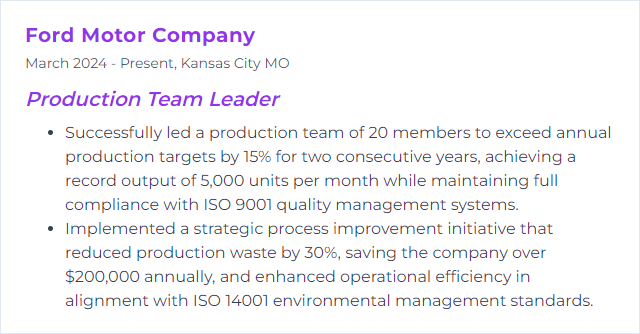Top 12 Production Team Leader Skills to Put on Your Resume
In the fast-paced world of production, having a resume that captures your leadership prowess is crucial for standing out. Highlighting your top production team leader skills effectively communicates your ability to drive efficiency, manage resources, and lead a team towards achieving operational excellence.
Production Team Leader Skills
- Lean Manufacturing
- Six Sigma
- Agile Management
- SAP ERP
- Quality Control
- Project Management
- AutoCAD
- SolidWorks
- Inventory Management
- Kaizen Methodology
- JIT (Just-In-Time)
- ISO Standards Compliance
1. Lean Manufacturing
Lean Manufacturing is a systematic approach to optimizing production by minimizing waste and maximizing flow, all in service of customer value. For a Production Team Leader, it means coaching the crew to spot non-value work, fix bottlenecks, and build habits that keep quality and throughput sharp.
Why It's Important
Lean trims waste, boosts efficiency, and lifts productivity. You get better quality, lower cost, faster delivery. Team morale climbs when problems shrink. Customers notice.
How to Improve Lean Manufacturing Skills
To strengthen Lean on the floor, focus on:
Continuous Improvement (Kaizen): Encourage frequent, small changes owned by the team. Make it normal to suggest, test, and adopt improvements.
5S Methodology: Sort, set in order, shine, standardize, sustain. Keep workspaces safe, clean, and obvious. Less hunting, fewer errors.
Value Stream Mapping: Map steps from supplier to shipment. Expose delays, rework, and handoff friction. Target the worst offenders first.
Just-In-Time (JIT): Sync production with demand to reduce inventory and wait time. Tight coordination, tight signals.
Empower the Team: Involve operators in decisions. Recognize wins. Grow skills. Engagement fuels ideas.
Root Cause Analysis: Use Five Whys or fishbone diagrams. Fix causes, not symptoms. Lock in countermeasures.
Cross-Training: Build range. Cross-skill so coverage holds when demand shifts or someone’s out.
Fold these into your daily rhythm and Lean gains stop being a project—they become the way you work.
How to Display Lean Manufacturing Skills on Your Resume

2. Six Sigma
Six Sigma is a data-driven method to reduce defects and variation. It leans on measurement, analysis, and disciplined control so processes run predictably and quality climbs.
Why It's Important
It cuts errors, stabilizes processes, and saves cost. Customers see fewer defects. Leaders get cleaner data to steer by.
How to Improve Six Sigma Skills
As a Production Team Leader, dial in on:
Education and Certification: Build capability with formal training (Yellow/Green Belt). Shared language speeds problem solving.
Process Mapping: Document current state. Reveal rework loops, delays, decision points.
Data Analysis: Use statistical tools such as Minitab or Excel add-ins. Validate causes, demonstrate impact, forecast gains.
Employee Involvement: Source ideas from the people closest to the work. Kaizen plus DMAIC plays well together.
Communication and Feedback: Share results, visualize metrics, invite critique. Transparency accelerates adoption.
Benchmarking: Compare to internal bests and external standards. Aim past average.
Consistent application of DMAIC and control plans hardwires improvements into daily operations.
How to Display Six Sigma Skills on Your Resume
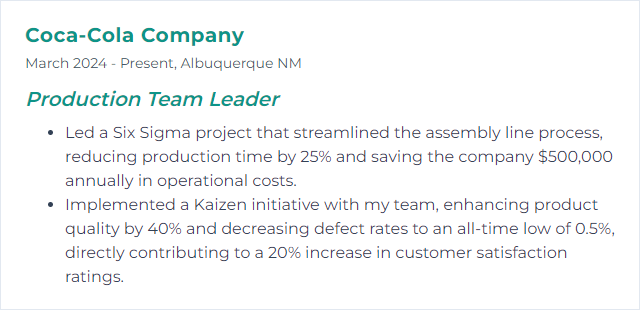
3. Agile Management
Agile Management is an iterative way to deliver value fast with cross-functional teams. Adapt as you learn. Short cycles, visible work, tight feedback.
Why It's Important
It sharpens responsiveness, improves quality, and nudges collaboration forward. Plans flex with reality instead of cracking under it.
How to Improve Agile Management Skills
Bring Agile to life by:
Fostering Collaboration: Daily touchpoints, clear boards, and lightweight documentation. Tools like Trello or Jira keep work visible.
Embracing Change: Reprioritize when new data lands. Adapt backlog, not just schedules.
Running Retrospectives: Inspect, learn, adjust. End each sprint with candor and action items.
Empowering the Team: Push decisions to the point of knowledge. Autonomy speeds outcomes.
Focusing on Customer Value: Sequence work by impact. Ship what matters first.
Tracking Agile Metrics: Watch lead time, cycle time, throughput, and quality. Let the numbers steer improvements.
Small iterations, steady feedback, fewer surprises.
How to Display Agile Management Skills on Your Resume
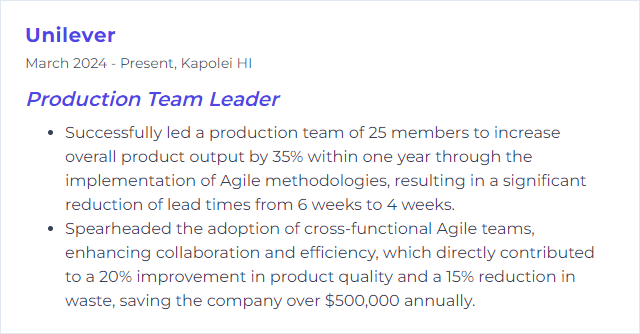
4. SAP ERP
SAP ERP integrates production, inventory, procurement, finance, and beyond into one system. For a Production Team Leader, it means cleaner planning, real-time visibility, and controlled execution.
Why It's Important
Single source of truth. Tighter schedules. Better material availability. Informed decisions—fast.
How to Improve SAP ERP Skills
Increase impact by:
Training: Upskill the team on core transactions, reporting, and exceptions. Confidence reduces workarounds.
Customization: Tailor screens, roles, and workflows to fit how your line runs.
Integration: Connect to shop-floor systems, maintenance tools, and planning apps to avoid double entry.
Automation: Automate repetitive steps and alerts. Cut manual errors; speed approvals.
Performance Monitoring: Use dashboards and KPIs for plan adherence, capacity, yield, and scrap. Act on exceptions.
Feedback Loop: Collect user pain points and prioritize fixes. Iterate configurations over time.
The result: fewer surprises, smoother flow, stronger throughput.
How to Display SAP ERP Skills on Your Resume
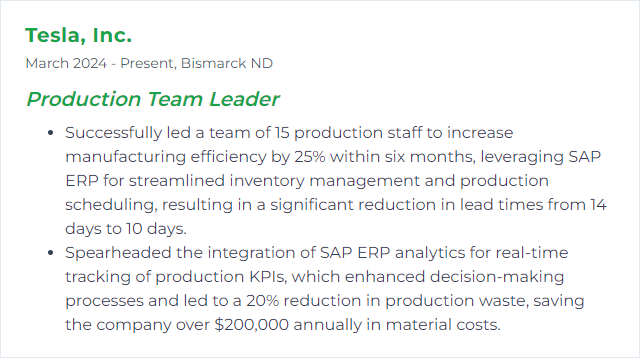
5. Quality Control
Quality Control (QC) is the system of checks and standards that ensure products meet requirements before shipment. Find defects early. Prevent recurrence. Protect the brand.
Why It's Important
Fewer defects mean happier customers and lower cost. QC builds trust, stabilizes processes, and supports continuous improvement.
How to Improve Quality Control Skills
Level up QC with:
Educate and Train: Teach standards, methods, and why they matter. Refresh often.
Adopt Recognized Standards: Align with frameworks such as ISO 9001 for consistent, auditable practice.
Use Quality Tools: Blend Lean and Six Sigma methods. Apply control charts, check sheets, FMEA.
Real-Time Monitoring: Use SPC and layered process audits. Close feedback loops quickly.
Supplier Quality: Qualify, audit, and monitor. Share specs and scorecards. Partner on fixes.
Culture of Quality: Reward first-time quality. Stop-the-line authority when defects appear.
Regular Reviews: Internal audits and management reviews to spot drift and standardize gains.
Quality becomes habit when it’s built into how the work happens.
How to Display Quality Control Skills on Your Resume
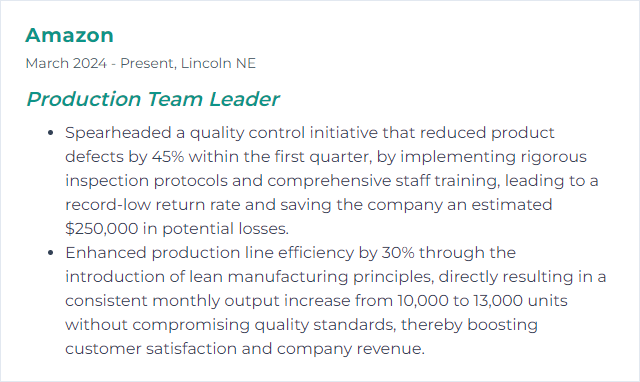
6. Project Management
Project management is the art of planning, sequencing, and delivering work within time and cost. For production leaders, that means orchestrating resources, removing blockers, and landing outcomes on schedule.
Why It's Important
It keeps priorities aligned, risks tamed, and budgets intact. Deadlines stop being guesses.
How to Improve Project Management Skills
Sharpen execution by:
Defining Clear Objectives: Write crisp goals and success criteria. No fog.
Communicating Early and Often: Cadence meetings, concise updates, open channels.
Using the Right Tools: Tools like Trello, Jira, or Smartsheet keep tasks and dependencies visible.
Monitoring Progress: Track milestones and critical path. Adjust when reality shifts.
Risk Management: Identify, rank, and mitigate. Keep a live risk register.
Delegating Wisely: Match tasks to strengths and bandwidth. Clarify ownership.
Learning Every Cycle: Gather feedback, capture lessons, update playbooks.
Clarity, visibility, and routine check-ins carry projects across the line.
How to Display Project Management Skills on Your Resume
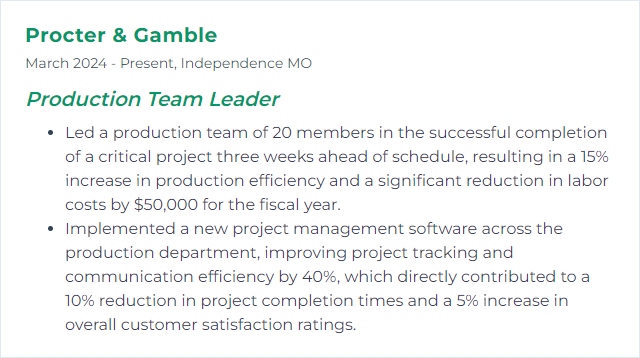
7. AutoCAD
AutoCAD is CAD software for precise 2D and 3D drawings. In production, it informs layouts, tooling, fixtures, and change impacts.
Why It's Important
Accurate models reduce rework, tighten fit, and streamline production planning. Less waste, cleaner execution.
How to Improve AutoCAD Skills
Boost results by:
- Enhancing Skills: Provide ongoing training and practice time.
- Customizing Tool Palettes: Tailor palettes for common parts and symbols.
- Implementing CAD Standards: Naming, layers, dimensions, title blocks—keep them consistent.
- Using AutoCAD on the Go: Mobile access for quick checks and markups.
- Automating Repetitive Tasks: Leverage AutoLISP or scripts to speed routine work.
- Keeping Software Current: Update to benefit from performance and feature improvements.
Consistency in standards plus automation equals speed and accuracy.
How to Display AutoCAD Skills on Your Resume
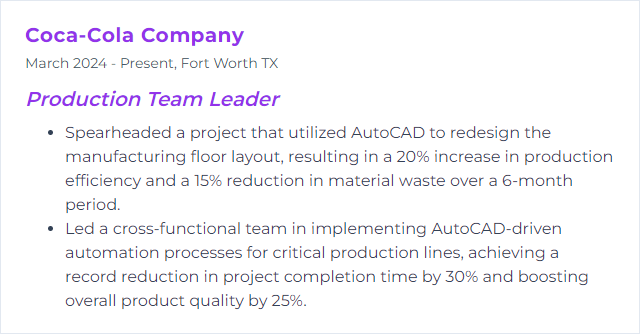
8. SolidWorks
SolidWorks is CAD/CAE software for creating and testing 3D models. It supports design, simulation, and documentation for mechanical parts and assemblies.
Why It's Important
Designs can be validated virtually before steel is cut. Fewer iterations, faster launch, better quality.
How to Improve SolidWorks Skills
Raise the bar by:
Training: Upskill designers and technicians on features, shortcuts, and workflows.
Templates and Standards: Build custom templates, title blocks, and drawing standards to reduce variation.
PDM System: Use Product Data Management to control versions and collaborate safely.
Performance Evaluation: Tune settings and hardware guided by SolidWorks performance testing.
Collaboration Tools: Use shared platforms (such as 3DEXPERIENCE) to coordinate work and reviews.
Automation: Create macros and API-driven scripts for repetitive, error-prone steps.
Feedback Loop: Regularly collect team input and refine templates, libraries, and methods.
Standardization plus PDM reduces chaos; automation adds speed.
How to Display SolidWorks Skills on Your Resume

9. Inventory Management
Inventory management governs how materials are ordered, stored, and consumed—plus how finished goods move out. The aim: have what you need when you need it, without drowning in stock.
Why It's Important
Right-sized inventory prevents line stops and cuts holding cost. Flow improves. Cash frees up.
How to Improve Inventory Management Skills
Strengthen control with:
Just-In-Time (JIT): Order to demand signals. Shrink buffers, but protect against variability.
Inventory Systems: Use software for real-time visibility and automated reorder points. Tools like Fishbowl or NetSuite can help.
Regular Audits: Cycle counts and full physicals to reconcile records with reality.
Better Forecasting: Blend history, seasonality, promotions, and market signals.
ABC Analysis: Focus on the vital few. Tighter controls for A items, simpler rules for C.
Supplier Partnerships: Share forecasts, set lead-time agreements, and align on MOQ and quality.
Team Training: Teach receiving, labeling, and transaction accuracy. Errors here ripple everywhere.
Clean data, disciplined processes, and good supplier ties keep inventory nimble.
How to Display Inventory Management Skills on Your Resume
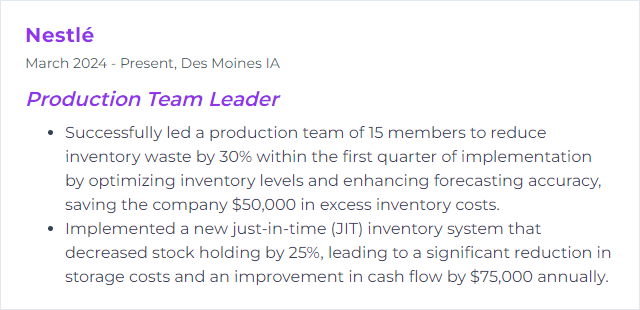
10. Kaizen Methodology
Kaizen is continuous improvement involving everyone—leaders, engineers, operators. Small steps, every day, compounding into big gains.
Why It's Important
It builds a habit of fixing problems at the source. Less waste, smoother flow, safer work, stronger teamwork.
How to Improve Kaizen Methodology Skills
Make Kaizen stick by:
Educating the Team: Share principles and examples. Show what good looks like.
Setting Clear Goals: Tie improvements to measurable targets—productivity, scrap, lead time.
Implementing 5S: Start here to expose issues and make standards visible.
Encouraging Small Improvements: Suggestion systems, quick experiments, rapid standard updates.
Visual Management: Kanban boards, andon signals, status at a glance.
Measure and Analyze: Use Pareto, trend charts, and run charts to focus effort.
Celebrate Wins: Recognize contributions—keep momentum alive.
Standardize and Iterate: Lock in gains, then look for the next step.
When everyone improves a little, all the time, performance surges.
How to Display Kaizen Methodology Skills on Your Resume
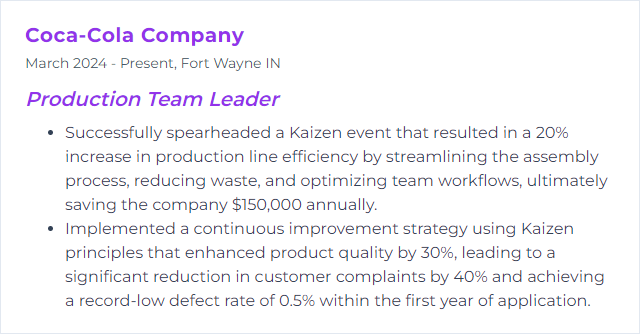
11. JIT (Just-In-Time)
JIT means producing and receiving items exactly when needed. Less inventory, less waiting, more flow.
Why It's Important
It trims carrying costs and exposes problems quickly. Responsiveness improves, defects fall, cash gets freed.
How to Improve JIT (Just-In-Time) Skills
Move JIT forward with:
Streamlined Supply Chain: Align lead times, delivery cadence, and quality with suppliers. Share schedules.
Kanban Systems: Use cards or digital signals to pull work and level load.
Right-Sized Buffers: Set minimums and maximums based on demand variability and lead time.
Quality at the Source: Poka-yoke, standardized work, and immediate containment reduce rework.
Train and Empower: Teach operators to spot flow issues and stop to fix.
Technology Support: ERP and shop-floor systems for real-time tracking and planning.
Relentless Review: Audit flow, eliminate waste, and revisit parameters regularly.
Pull beats push when signals are clean and suppliers are in tune.
How to Display JIT (Just-In-Time) Skills on Your Resume
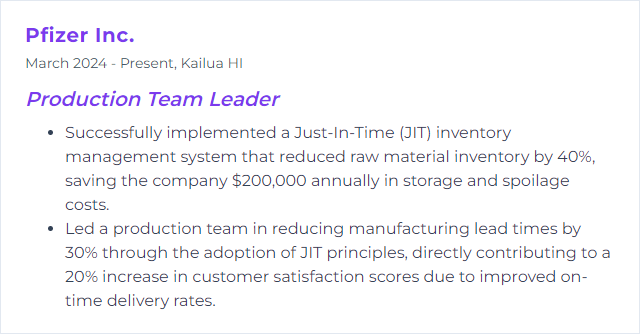
12. ISO Standards Compliance
ISO Standards Compliance means your processes align with recognized international standards for quality, safety, and consistency. Think ISO 9001 for quality management, plus other domain-specific standards as needed.
Why It's Important
It anchors reliable processes, consistent output, and safer operations. Customers trust you. Regulators stay satisfied.
How to Improve ISO Standards Compliance Skills
Strengthen compliance by:
Educating the Organization: Train on the relevant standards and how they apply to daily work.
Building a QMS: Document processes, define ownership, control changes, and drive corrective actions aligned to ISO 9001 principles.
Internal Audits: Plan routine audits, capture findings, and verify closures. Treat them as learning, not blame.
External Certification: Work with accredited bodies for third-party audits and certification.
Continuous Improvement: Use CAPA, Kaizen, and management reviews to raise the bar.
Staying Current: Monitor updates to standards and related regulations; adjust documentation and training promptly.
Compliance isn’t a binder on a shelf—it’s the way you run the plant.
How to Display ISO Standards Compliance Skills on Your Resume
